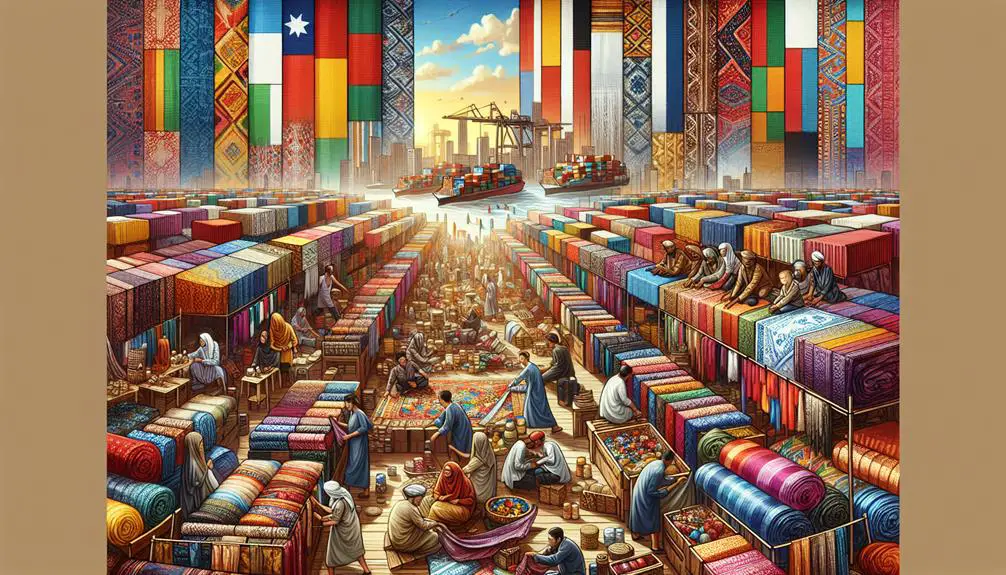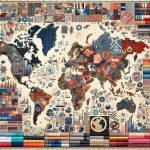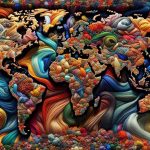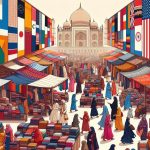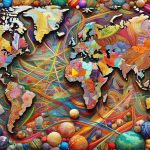When you consider the less glamorous side of economic engines, fabric might not immediately come to mind. Yet, it's a cornerstone of industries, cultures, and global trade. Think about how many jobs the textile sector creates, sustaining communities worldwide. The fabric industry is also a mirror of our times, reflecting shifts toward sustainability and ethical production. With technological advancements, you're witnessing innovations that could redefine the future of textiles. Curious about how these threads weave through the global economy? You'll find that fabric's role is more influential than you might expect.
Table of Contents
Key Takeaways
- The fabric industry is crucial for global employment, providing millions of jobs and boosting local economies.
- Textile trade routes historically transformed societies through cultural exchange and economic growth.
- Technological advancements in textiles drive innovation, enhancing sustainability and efficiency in production.
- Global trade dynamics in fabric impact costs, regulations, and competitive positioning for economies.
- Sustainable fabric alternatives are reshaping consumer preferences and promoting eco-friendly practices in the industry.
Historical Significance of Fabric
Throughout history, fabric has played an essential role in shaping economies and cultures around the world. You can trace the roots of the textile revolution back to ancient civilizations where fabric wasn't just a commodity but a symbol of cultural significance. Think of the intricate silk garments of China or the richly woven textiles of Egypt. These weren't just pieces of cloth; they represented status, power, and identity.
As you explore further into this subject, you'll find that the textile revolution transformed societies. It led to the establishment of trade routes, spurred technological advancements, and even influenced political dynamics. For instance, the Silk Road wasn't merely a trade route; it was a conduit for cultural exchange, spreading ideas, religions, and innovations alongside luxurious silks.
You can appreciate how fabric's historical significance extends beyond economics. It's woven into the very fabric of societies, influencing art, tradition, and daily life. Whether it's the ornate tapestries of medieval Europe or the vibrant saris of India, fabric has continually shaped and reflected the cultural identity of civilizations.
Understanding this historical significance allows you to grasp the profound impact textiles have had on global development.
Fabric Industry and Employment
As fabric's historical significance underscores its cultural impact, today's textile industry remains a pivotal source of employment for millions worldwide. You can't overlook the importance of fabric production in driving the global economy.
From spinning to weaving, each stage requires skilled labor, creating a multitude of textile jobs. These roles are essential in both developing and developed nations, providing financial stability and boosting local economies.
By understanding the intricacies of the fabric industry, you'll appreciate how labor-intensive this sector is. Workers in textile factories often specialize in specific tasks, making their skills indispensable. Your knowledge of these processes will reveal how automation and innovation continually reshape the landscape, yet human expertise remains irreplaceable.
Moreover, textile jobs aren't limited to factory floors. Design, marketing, and management positions also play significant roles in the industry. As you explore further, you'll see how these jobs contribute to a complex economic web that supports millions of livelihoods.
Grasping the fabric industry's employment dynamics enables you to recognize its broader economic implications, making you appreciate the seamless integration of tradition and modernity in this crucial sector.
Global Trade Dynamics
In recent years, global trade dynamics in the fabric industry have evolved, driven by shifts in supply chains and consumer preferences. You're witnessing a transformation where traditional borders blur, and the flow of materials becomes more complex. It's crucial to understand that effective supply chain management now demands a sharp focus on tariffs and regulations. These factors can significantly change costs and competitive positioning.
You can't overlook the impact of tariffs. With trade policies constantly changing, staying up-to-date on tariff structures can make the difference between profit and loss. Navigating these regulations requires not only compliance but also strategic foresight. You must foresee changes and adjust sourcing strategies accordingly.
Furthermore, consumer preferences are increasingly shaping global supply chains. Sustainable and ethically produced fabrics aren't just passing fads; they're becoming prerequisites. Consequently, you must guarantee transparency and traceability in your supply chain, from raw material sourcing to the final product.
Adapting to these evolving dynamics isn't a choice if you strive for excellence in the fabric industry. By staying well-informed and flexible, you can capitalize on these shifts to your benefit, ensuring your position in the global market remains robust.
Technological Innovations in Textiles
You'll be amazed by how technological innovations are transforming textiles.
Smart fabrics that monitor health and sustainable technologies reducing environmental impact are leading the way.
Let's explore how these advancements are reshaping the industry.
Smart Fabrics Evolution
Smart fabrics have revolutionized the textile industry by integrating advanced technology directly into garments. With wearable technology, you're not just wearing clothes; you're donning intelligent systems designed to enhance your life.
Fabric integration has reached new heights, embedding sensors, conductive fibers, and microprocessors seamlessly into textiles. Imagine your shirt monitoring your heart rate or your jacket generating heat in cold weather. These aren't futuristic concepts; they're reality, transforming everyday apparel into multifunctional devices.
You're witnessing the dawn of garments that adapt to your needs. For instance, smart fabrics can adjust their properties based on external conditions. Athletes benefit from moisture-wicking materials that also track performance metrics, while patients can wear clothes that monitor essential signs, alerting healthcare providers in real time.
This fabric evolution isn't just about convenience; it's about creating a responsive environment around you.
As you explore further into the world of smart fabrics, you'll discover the immense potential they hold. Whether it's for health, fitness, or comfort, the integration of technology into textiles is setting new standards.
Embrace this revolution, and you'll find that smart fabrics offer unprecedented benefits, making your everyday life smarter and more efficient.
Sustainable Fabric Technologies
As the textile industry evolves, sustainable fabric technologies are becoming a pivotal focus for reducing environmental impact.
You'll find that the integration of eco-friendly materials like organic cotton, hemp, and recycled polyester is revolutionizing the way fabrics are produced and used. These materials not only reduce the carbon footprint but also minimize water and chemical use, thereby fostering a more sustainable production cycle.
To truly master sustainable fabric technologies, you should explore innovations in circular fashion. This concept emphasizes designing products with their entire lifecycle in mind, ensuring that fabrics can be reused, recycled, or composted at the end of their life. Techniques such as closed-loop recycling and biodegradable textiles are at the forefront of this movement, providing practical solutions to textile waste.
Furthermore, advancements in digital printing reduce the need for dyes and water, making the production process cleaner and more efficient.
Environmental Impact
You'll notice that fabric production isn't just about creating textiles; it's also about consuming vast resources, generating pollution, and producing waste.
These environmental issues demand attention, but there are sustainable alternatives that can mitigate the damage.
Resource Consumption
The production of fabric depletes natural resources and contributes to environmental degradation. You can make a substantial impact by understanding how sustainable production and ethical sourcing can mitigate these effects. When you choose fabrics produced through sustainable methods, you're ensuring that the resources used are renewable and managed responsibly. Ethical sourcing guarantees that the labor involved respects both human rights and the environment.
Consider the following points to grasp the extent of resource consumption in fabric production:
- Water Usage: Fabric production, especially for cotton, demands vast amounts of water. Producing one kilogram of cotton requires about 20,000 liters of water.
- Energy Consumption: The textile industry is energy-intensive. The global textile sector consumes nearly 1.5% of the world's total energy production, contributing significantly to carbon emissions.
- Land Use: Extensive land is used for growing natural fibers. This often leads to deforestation and loss of biodiversity.
Pollution and Waste
Beyond resource consumption, fabric production also generates substantial pollution and waste that harm the environment. You mightn't realize it, but the process of dyeing and finishing textiles releases toxic chemicals into waterways, affecting both ecosystems and human health.
Factories often emit large quantities of greenhouse gases, contributing to climate change. The sheer volume of waste produced is staggering; tons of fabric scraps and unsold garments end up in landfills every year, taking decades to decompose.
Effective waste management is vital to mitigate these impacts. You need to understand that reducing waste at the source is far more efficient than dealing with it post-production. Implementing stringent pollution control measures can greatly reduce harmful emissions and effluents. This involves adopting cleaner technologies and ensuring proper treatment of wastewater before it's discharged.
Moreover, you should be aware that the responsibility doesn't lie solely with manufacturers. Consumers play a pivotal role too. By making informed choices and supporting brands that prioritize waste management and pollution control, you can drive change in the industry.
It's crucial to be proactive in understanding where your fabrics come from and how they impact the environment.
Sustainable Alternatives
Exploring sustainable alternatives in fabric production can greatly reduce environmental impact and foster a healthier planet. By embracing eco-friendly materials and innovative processes, you can contribute to a circular economy that minimizes waste and maximizes resource efficiency.
To start, consider these three sustainable alternatives:
- Organic Cotton: Unlike conventional cotton, organic cotton is grown without harmful pesticides and synthetic fertilizers. This reduces soil degradation and water contamination, making it a more eco-friendly material.
- Recycled Fabrics: Using fabrics made from recycled materials, such as polyester from plastic bottles or repurposed textile waste, helps reduce the demand for virgin resources. This not only cuts down on landfill waste but also decreases energy consumption in production.
- Bamboo Fabric: Bamboo grows rapidly without the need for pesticides or excessive water. When processed responsibly, bamboo can be transformed into a soft, durable fabric that's biodegradable and sustainable.
Future Trends in Fabric Industry
As the fabric industry evolves, expect to see a significant shift towards sustainable and smart textiles. Fabric recycling and a circular economy will become increasingly crucial. Imagine a world where the life cycle of every fabric is meticulously managed. You'll see materials being reused and repurposed, reducing waste and conserving resources. Embracing fabric recycling not only benefits the environment but also revolutionizes how we perceive and utilize textiles.
Digital textiles and virtual fashion are set to transform your wardrobe. Picture garments that adapt based on digital inputs, offering unparalleled customization. Virtual fashion will redefine the shopping experience, allowing you to try on clothes in a virtual space before making a purchase. This not only personalizes your shopping but also minimizes returns, further contributing to sustainability.
Moreover, advancements in smart textiles will integrate technology into everyday wear. Think of fabrics that monitor health metrics or adjust to temperature changes. As these innovations take hold, you'll find yourself at the forefront of a more responsible and technologically advanced fabric industry.
Frequently Asked Questions
What Are the Primary Materials Used in Fabric Production Today?
You're asking about the primary materials in fabric production today. Cotton, polyester, and wool lead the market, but don't overlook sustainable alternatives like bamboo and hemp. Technological innovations are also introducing recycled fibers and bio-based fabrics.
How Do Cultural Differences Influence Fabric Preferences and Uses?
You'd be fascinated by how cultural influences and textile traditions shape fabric preferences. Coincidentally, fabric symbolism and societal norms intertwine, creating diverse uses. You'll find that each culture's unique history deeply impacts their fabric choices and applications.
What Are the Key Challenges Faced by Small-Scale Fabric Producers?
You face key challenges like managing a complex supply chain and integrating sustainability efforts. Balancing costs with eco-friendly practices and competing with larger producers can be overwhelming, but mastering these can set you apart in the market.
How Does Fabric Pricing Vary Across Different Regions?
You might think fabric pricing is straightforward, but it's not. Prices vary across regions due to differences in supply chain efficiency and market demand. Mastering this helps you navigate the complexities of the global textile market.
What Role Do Consumer Trends Play in Shaping the Fabric Industry?
You shape the fabric industry by choosing sustainable fashion over fast fashion. Your preferences influence manufacturers to adopt eco-friendly practices, driving demand for organic materials and ethical production methods, transforming the market towards sustainability.
- Tetron Fabric for Marine Applications: Durability and Use Cases - June 18, 2025
- Tetron Fabric for Outdoor Furniture: Weather Resistance and Care - June 18, 2025
- Tetron Fabric for Wall Coverings: Style and Application Tips - June 18, 2025

